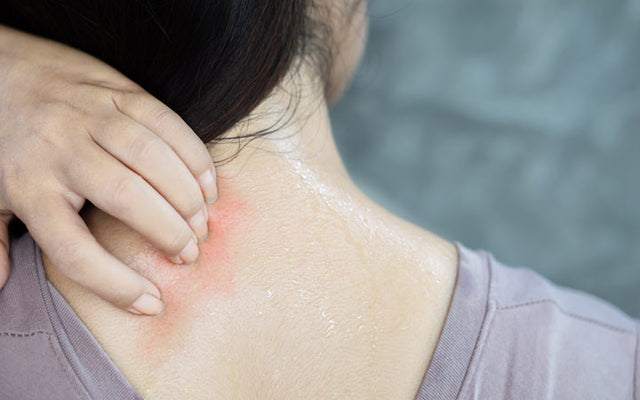If you thought summer skin care is all about sunscreens and hydration, think again. A common skin complaint in the scorching summers is heat rash. The condition also goes by other names like sweat rash or prickly heat. In scientific terms, it is called miliaria.
If you’re someone who gets a heat rash almost every summer, this article is for you. From causes to effective treatments and risks, we have covered it all in the post below.
Highlights:
What Is Heat Rash? Does Heat Rash Spread?
Heat rash or miliaria [1] develops on the skin when your pores get blocked and the sweat can't find its way out. Heat rash can spread on the body, but it is not harmful or contagious.
A heat rash is divided into the following types [2]:
1. Miliaria Crystallina
Miliaria crystallina is a common and milder form. There are small clear or white bumps filled with fluid on the surface of your skin that can often burst. It is common in babies and does not itch or pain.
2. Miliaria Rubra
Miliaria rubra is common in adults. It is a cause of discomfort because it develops deeper in the epidermis. It looks like red and itchy bumps.
3. Miliaria Profunda
Miliaria profunda is the least common form and can turn out to be chronic. It occurs in adults after intense workout sessions involving sweat. It can lead to larger, flesh-colored bumps occurring in the dermis.
What Are The Symptoms Of Heat Rash?
- Blisters or red bumps
- Prickly or itching feeling on the skin
- Redness and mild swelling [3]
Inner thighs, underarms, elbow and neck are the most common areas that can develop a heat rash.
What Causes Heat Rash?
Heat rash is often a result of friction on the surface of your skin. It usually occurs in hot climatic conditions. Workouts that cause sweat and prolonged periods of bed rest in warm environment can also cause heat rash.
How To Treat Heat Rash?
1. Oral Antihistamines
Antihistamines [4] are a class of drugs that treat allergies or inflammations. You can consider OTC (over-the-counter) antihistamines like cetirizine, loratadine and fexofenadine for heat rash.
2. Cold Compress
Heat rash makes the skin irritated and cold compress is your best bet to soothe an irritated skin. You can use a cloth soaked in cold water or ice wrapped in cloth.
3. Cool Bath
Cool baths and showers are an instant fix for heat rash. Cool water soothes the skin and can help unclog the pores.
4. Loose Cottons
Cotton fabrics ease the symptoms of heat rash. Wear loose clothing so that the friction on the surface of the skin is reduced.
5. Oatmeal Bath
A cool bath with oatmeal [5] can alleviate heat rash. It is a humectant, meaning it can attract moisture from the air and trap it in the skin. Also, oatmeal is a great anti-inflammatory agent.
6. Talcum Powder
Prickly heat powder can be used to treat heat rash. They contain cooling agents like menthol, camphor, essential oils like sandalwood oil, rose oil, peppermint oil, neem oil, kaolin, etc. which helps soothe the heat rash.
7. Skin Creams
OTC hydrocortisone [6] creams can help with heat rashes. You can apply this cream on your skin 1-2 times a day till the heat rash disappears completely. Hydrocortisone is a steroid that reduces the activity of chemicals causing inflammation, itching and redness.
8. Calamine Lotion
Calamine lotion is effective against heat rash. It is made up of zinc oxide, 0.5% ferric oxide, phenol and calcium hydroxide.
9. Air Conditioning
Cooling your body in an air conditioned room and avoiding long stay outdoors in hot weather can ease the symptoms of a heat rash within a few days.
10. Aloe Vera
Apply freshly extracted aloevera or an aloe vera [7] gel onto skin. Aloe vera is an anti-inflammatory, moisturizing and soothing ingredient.
11. Drink More Water
Heat rash happens when the body overheats and sweats. You can control this by drinking lots of water to cool down your body and skin.
How To Prevent Heat Rash?
- Avoid tight clothing at all costs during summers. Your skin needs to breathe and the sweat needs to escape.
- Refrain from using heavy creams or lotions on your skin in summer.
- Stay indoors under cool conditions and keep yourself hydrated.
- Use soaps that are not drying and do not contain any dyes or fragrances.
What Are The Risk Factors For Heat Rash?
Hot environments, intense workouts, prolonged bed rest and tight clothing contributing to sweating are all the risk factors for a heat rash. New born babies are also at a greater risk of developing heat rashes, which could also cause itching in many cases.
How Long Does It Take For Heat Rash To Go Away & When Should You See A Doctor?
Heat rash usually goes away in 3-4 days. It is not a serious skin condition and often goes away without treatment. If it doesn’t, it is time to consult your doctor. Also talk to your doctor if you have:
- Fever
- Chills
- Pain
- Pus from the bumps
Wrapping up
We hope you now know how to spot a heat rash, given all the symptoms and how to treat it effectively. Prevention of heat rash lies in avoiding sweating as much as possible. Post workout, always take a shower and try to avoid staying outdoors for too long in the summer.
1. https://www.healthdirect.gov.au/heat-rash
2. https://www.ncbi.nlm.nih.gov/books/NBK537176/
3. https://www.nidirect.gov.uk/conditions/heat-rash-prickly-heat
4. https://www.ncbi.nlm.nih.gov/pmc/articles/PMC5895478/
5. https://pubmed.ncbi.nlm.nih.gov/17373175/
Recommended Products
Was this Article helpful?
- Least helpful
- Most helpful











